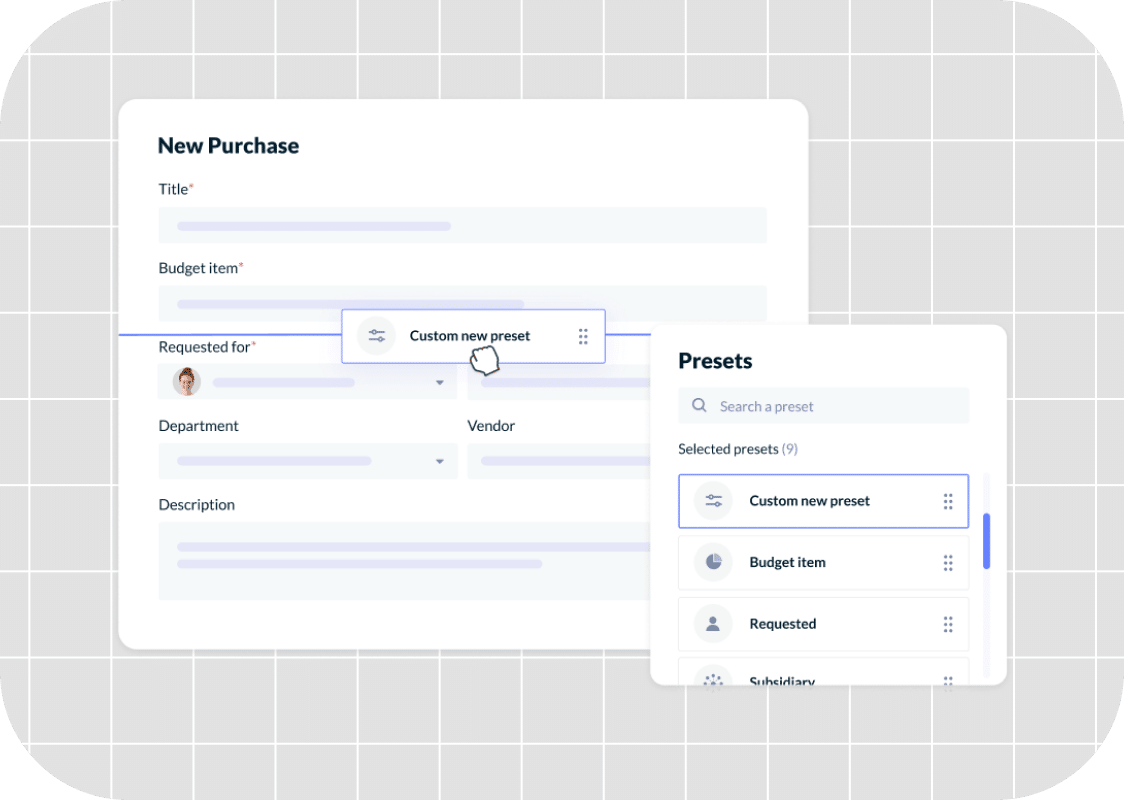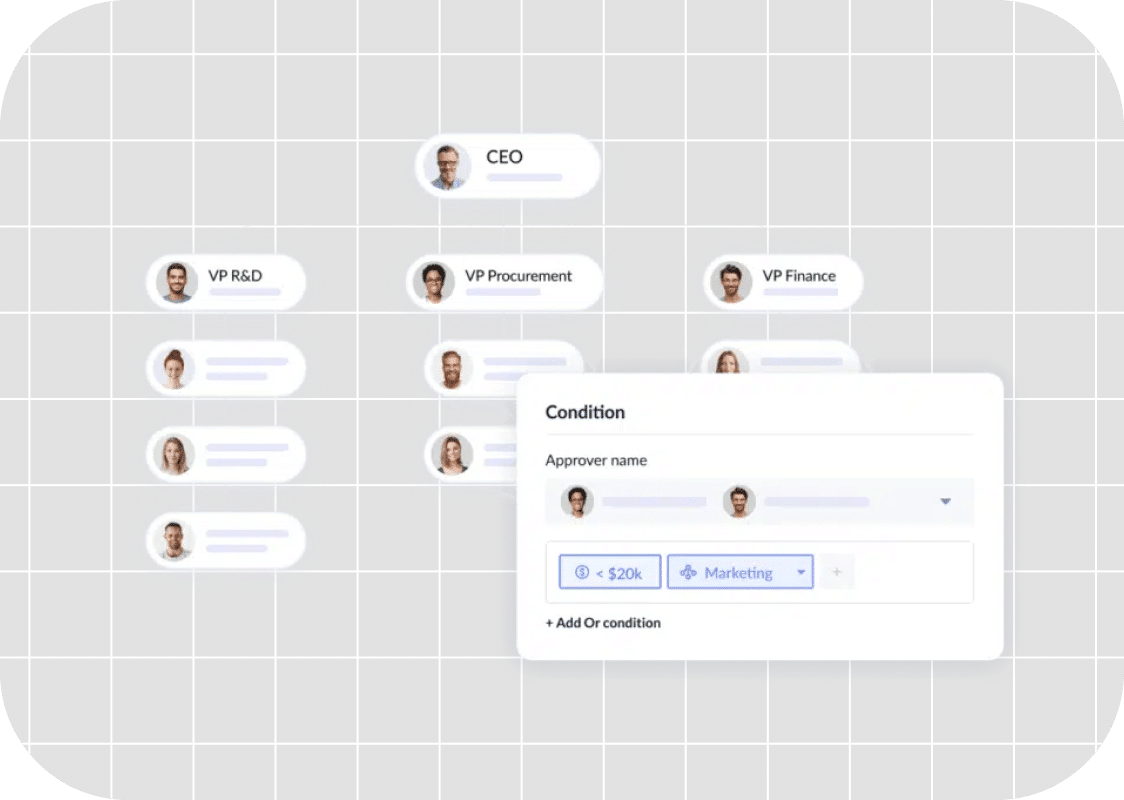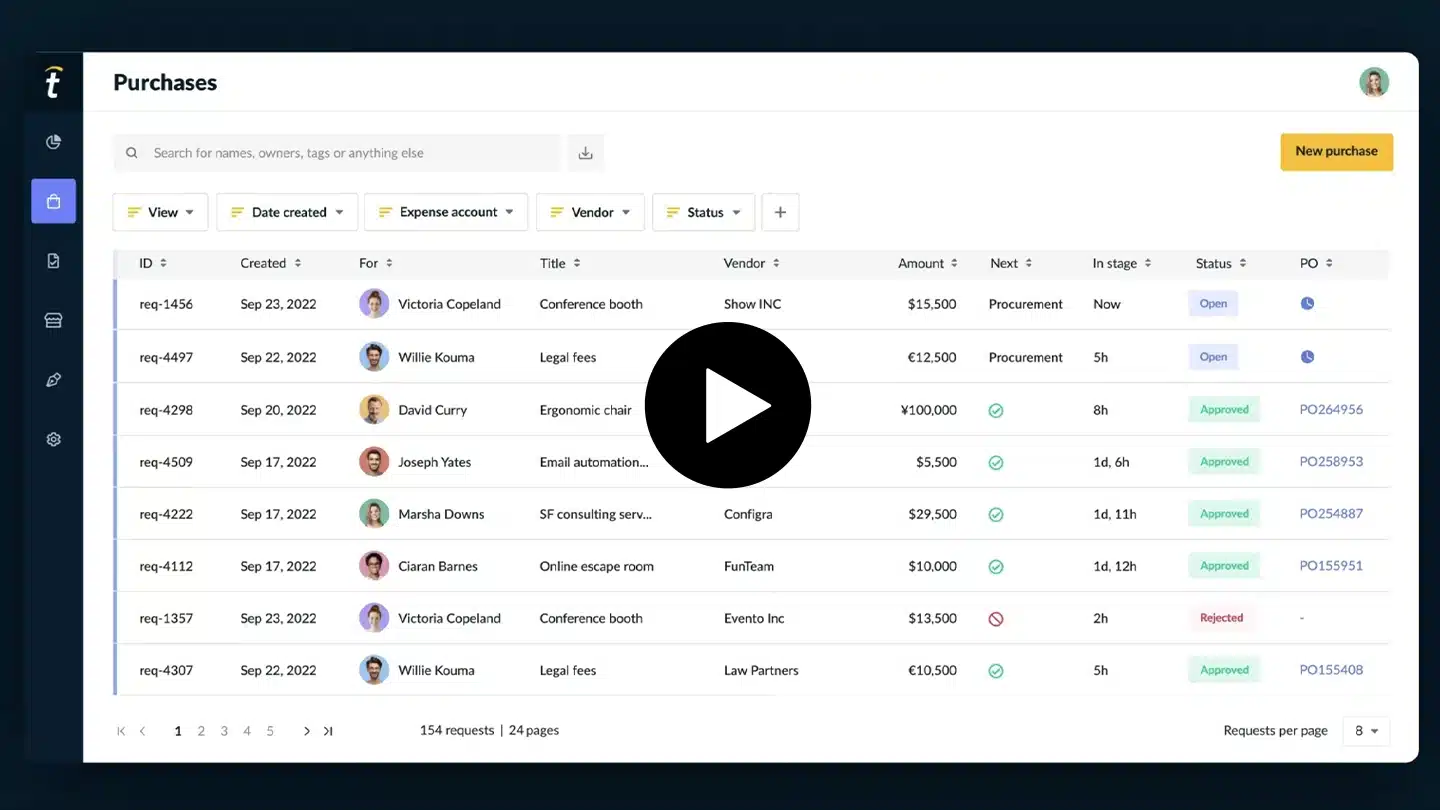Simple Intake Management
Simplify the purchase requisition process, control spend, and capture spend intent early with customizable, employee-friendly intake forms. Gather the necessary data and allow Tipalti to initiate the right workflow for quicker approval.
Intake Management Features
Bring More Spend Under Management
Take control of your spending from the start with flexible, AI-powered intake forms that streamline procurement requests. Our solution automates approvals, giving you a clear view of every purchase across entities and currencies.

Flexible, Customizable Procurement Intake Forms
Tailor request forms to your company’s unique policies, processes, and departmental or location-specific requirements with Tipalti’s powerful dynamic procurement intake feature. Employees can easily submit spend requests, capturing all critical information upfront.
Guided Intake Forms Powered by AI
Employees create requests using a natural language input model powered by Tipalti AI℠. The system automatically generates a purchase request, including creating a title, selecting the correct payee, setting items and prices, classifying requests, and suggesting relevant information, even if the user doesn’t initially provide it.

Approval Flow on Autopilot
Approval flows are defined based on your organizational chart, budget items, and custom rules. Once purchase requests are submitted via our procurement intake form, they’re auto-routed to the appropriate approvers according to our smart logic. Approvers can approve, reject with a note, or consult with legal, finance, or IT when needed.
Unified Purchases Panel
Gain full control over all your spend requests with our intuitive tracking system. Effortlessly monitor the status of all your requests via our dashboard-style purchase table, ensuring you’re always informed about your purchases.
Multi-Entity and Multi-Currency Support
Set up requests in any currency and tailor them to your entity’s spend policies. You can precisely configure supplier settings, selecting the currency for payments and restricting requestors to certain currencies and subsidiaries.
Platform Features
Work smarter, not harder
With AI and machine learning capabilities, an intuitive UX, and quick and easy global payments, you can drive unprecedented efficiency.
Integrations
Pre-built connections to extend automated workflows
Easily extend and simplify your workflows with pre-built integrations and powerful APIs for your ERPs, accounting systems, performance marketing platforms, HRIS, SSO, Slack, credit cards, and more.
How It Works
Up and Running in Weeks, Not Months
Get up and running fast with personalized onboarding and dedicated support.
Step 1
Plan
Kickstart your success with a comprehensive setup call to review your procurement workflow, set up SSO integrations, validate technical configurations, and prepare for training.
Step 2
Configure
Our customer onboarding experts set up your Procurement instance, configure requirements, and complete the User Acceptance Test (UAT) for all the procurement workflows.
Step 3
Deploy
Our customer onboarding experts set up your Procurement instance, configure requirements, and complete the User Acceptance Test (UAT) for all the procurement workflows.
Step 4
Adopt
Boost user adoption using change management during launch. We’ll support you with best practices and communication strategies and fine-tune the needs for optimal adoption.
Step 5
Optimize
Our Customer Success and Support teams provide dedicated support and technical assistance by phone and email. They’ll learn your goals and offer tailored solutions to help you achieve them.
Customer Stories
Don’t just take our word for it,
see what our customers are saying

Ready to save time and money?
Book a demo to get started today and take control of your finance operations with Tipalti.
Intake Management FAQs
What is intake management software?
Intake management software is designed to streamline and automate collecting, organizing, and managing incoming requests, inquiries, or applications from clients, customers, or internal teams.
This type of software is used in various industries, including finance, legal, healthcare, marketing, and customer service, to handle initial interactions and requests more efficiently.
Key Features of Intake Management Software
- Automated workflows: tools to automate the routing, assignment, and follow-up of intake requests to the appropriate teams or individuals based on predefined criteria, like the type of request, urgency, or location.
- Customized intake: users can create and customize intake forms to collect relevant customer data. These forms can be tailored with fields specific to the company’s needs, such as name, contact details, service type, and other necessary information.
- Centralized data storage: the software provides a centralized database where all intake information is stored, organized, and easily accessible. This helps prevent data loss, reduces manual data entry issues, and ensures all team members can access the most up-to-date information with real-time visibility.
- Analytics and reporting: reporting tools to analyze data related to intake requests, such as response times, types of requests received, and conversion rates. This information helps businesses identify trends, improve processes, and allocate resources more effectively.
- Communication tools: this includes integrated communication features like email, chat, and messaging to facilitate communication between the company and the client or customer during the intake process.
- Integrations: integrates with other tools like Customer Relationship Management (CRM), Electronic Health Records (EHR), or contract management software to ensure seamless data flow across all platforms.
- Task management: manage and track tasks associated with each intake request, from initial submission to resolution or conversion. This is crucial for ensuring that no requests are overlooked or delayed.
What is procurement intake?
Procurement intake is the initial process of collecting, reviewing, and approving requests for goods, services, or resources from within an organization.
Procure-to-pay is the entry point for end users—such as departments, teams, or individuals—to communicate their purchasing needs to the procurement or purchasing team.
Why do businesses need intake-to-procure solutions?
Businesses need intake-to-procure solutions to streamline the entire process from the initial request for goods or services (intake) to the final procurement and fulfillment.
These solutions provide a comprehensive approach to managing business needs by integrating all the steps involved in the procurement process, from intake and approval to sourcing, purchasing, and vendor management.
Key Reasons Why Businesses Need Intake-to-Procure Solutions
-
-
- Faster procurement cycle times
- Automated workflows ensure that procurement requests are reviewed and approved fast, reducing lifecycle times from source-to-pay.
- Software often includes tools for quickly identifying and onboarding suppliers, allowing companies to respond more rapidly to market conditions or changing needs.
- Enhanced visibility and control:
- These solutions provide visibility into every stage of procurement orchestration, from initial request to final delivery. This helps procurement managers track request status, identify bottlenecks, and make informed decisions quickly.
- All procurement-related data is in one spot, enabling better oversight and control over spending, supplier performance, and compliance with internal policies and external regulations.
- Better risk management and compliance
- Intake-to-procure solutions enforce rules and guidelines at every stage of the process to ensure that all procurement activities comply with organizational policies, industry standards, and regulatory requirements.
- Automating approvals and tracking activities reduces the risk of fraud, duplicate payments, and human errors that lead to costly mistakes.
- Improved efficiency and productivity
- Intake-to-procure solutions automate time-consuming tasks such as data entry, approval routing, and order processing, freeing up teams to focus on more strategic activities.
- By providing a single platform for the entire procurement process, these solutions eliminate silos and reduce the need for manual handoffs, minimizing timelines and errors.
- Faster procurement cycle times
-
Additional Benefits
- Cost savings and cost control
- Enhanced collaboration and communication
- Scalability and flexibility
- Handling increased volumes
- Data-driven decision-making
How do you streamline the procurement intake process for efficiency?
To simplify the procurement intake process, businesses can implement several best practices and use technology to automate and optimize the various steps involved.
A streamlined procurement intake process will reduce manual work, accelerate approvals, enhance compliance, and ultimately lead to cost savings and improved supplier management.
Steps to Streamline the Procurement Intake Process
- Standardize and digitize intakes
- Develop standardized procurement request templates that include all necessary fields, like item descriptions, quantities, specifications, budget details, and approval signatures. This helps ensure consistency across all requests.
- Replace paper-based forms with digital ones that can be completed and submitted online. Digital forms are more accessible to track, update, and automate, reducing manual errors and delays.
- Implement automated workflows
- Use a procurement management solution or workflow automation tool to route requests to the appropriate approvers based on predefined rules. Automating approvals minimizes delays caused by manual handoffs and reduces the risk of overlooked requests.
- Establish clear approval hierarchies and thresholds that are based on request type, value, or department. This ensures only relevant stakeholders are involved in the approval process, speeding up decision-making.
- Leverage integrated procurement software
- Use a procurement software solution integrating all functions—intake, approval, sourcing, and purchasing—into one platform. This ensures reduced data silos, real-time visibility, and simplifies tracking and reporting.
- Choose tools with collaboration features that allow procurement teams and requesters to communicate, share documents, and resolve issues in real-time, reducing back-and-forth communications.
- Define clear policies
- Define procurement policies, including preferred suppliers, spending limits, approval processes, and compliance requirements. Make sure these policies are easily accessible to all employees.
- Conduct training sessions to educate teams about the procurement process, policies, and available tools. This reduces errors and ensures smooth adherence to procedures.
- Utilize supplier portals and catalogs
- Use self-service supplier portals where approved suppliers can upload their catalogs, update pricing, and manage their profiles. This streamlines the sourcing process and ensures all procurement requests are matched with pre-approved suppliers.
- Develop internal catalogs for frequently purchased items and services from preferred suppliers. This simplifies procurement for recurring purchases, reduces the need for multiple approvals, and speeds up order placement.
- Monitor and analyze performance
- Monitor key performance indicators, such as compliance rates, average processing time, and approval turnaround time, regularly to identify bottlenecks and areas for improvement.
- Hold periodic reviews of the procurement intake process to identify inefficiencies and implement continuous improvement strategies. Solicit feedback to identify pain points and areas for enhancement.
- Implement a process for pre-approval
- Establish a pre-approval process for commonly purchased items or services. Organizations can reduce the need for repeated approvals for similar requests by setting up pre-approved purchasing agreements or blanket purchase orders.
- Use procurement cards (p-cards) for low-value purchases, which can streamline the process for small, routine expenses, reducing the burden on the procurement team.
How does Tipalti AI improve the request generation process?
Tipalti AI improves the request generation process by leveraging artificial intelligence to automate various aspects of procurement and payment workflows.
Tipalti is a user-friendly financial technology platform specializing in global payables automation. Its AI capabilities help streamline the intake-to-procure process by enhancing data accuracy, reducing manual effort, and speeding up approvals.
Ways Tipalti AI Improves the Request Generation Process
- Automated data entry and extraction
- OCR (Optical Character Recognition): Tipalti AI uses Optical Character Recognition (OCR) to automatically extract and digitize data from invoices, purchase orders, receipts, and other documents. This eliminates the need for manual data entry, reduces errors, and speeds up the request generation process.
- Data mapping: AI algorithms automatically map extracted data to the correct fields in the procurement system, ensuring all data is accurately captured and organized for further processing.
- Intelligent supplier matching and validation:
- Supplier data verification: Tipalti AI automatically validates supplier information against multiple databases, including tax authorities, financial institutions, and sanctioned lists. This ensures all supplier details are accurate and compliant with regulatory requirements before a request is generated.
- Preferred supplier identification: AI tools can recommend or automatically select preferred suppliers based on historical data, pricing, performance metrics, and predefined business rules, ensuring optimal supplier selection during the request process.
- Smart categorization and coding:
- Automated GL coding: Tipalti AI automatically assigns General Ledger (GL) codes to procurement requests based on predefined rules and historical data, optimizing the request generation process and ensuring accurate reporting.
- Expense classification: AI classifies expenses into appropriate categories by analyzing the content and context of requests, invoices, or receipts, improving compliance and reducing the risk of misclassification.
- Dynamic approval routing:
- Automated approval workflows: Tipalti AI dynamically routes procurement requests to the appropriate approvers based on predefined rules, policies, and request attributes such as value, department, or type of expense. This reduces human intervention, speeds up the approval process. It ensures that the right stakeholders review all requests.
- Prioritization of requests: AI can prioritize requests based on factors like urgency, budget impact, or supplier terms, ensuring that critical procurement needs are addressed promptly.
- Enhanced compliance and fraud detection:
- Compliance monitoring: Tipalti continuously monitors procurement activities for compliance with internal policies and external regulations. The system can flag any suspicious transactions, duplicate payments, or policy violations, reducing non-compliance risk.
- Fraud detection: AI employs machine learning (ML) algorithms to detect unusual patterns that could indicate fraud, such as repeated requests from the same supplier with slight variations, or irregular spending spikes.
Additional Ways Tipalti AI Improves the Request Generation Process
- Predictive analytics for spend optimization
- Natural Language Processing (NLP) for user input
- Real-time reporting and feedback
- Continuous learning and improvement
What are the benefits of using intuitive guided forms for requesters?
Using intuitive guided forms for requesters offers several benefits that streamline the procurement process, enhance user experience, and improve data accuracy.
Guided forms are designed to lead requesters through the process step-by-step, ensuring all necessary information is captured correctly while minimizing inefficiencies and errors.
Benefits of Using Intuitive Guided Forms for Requesters
- Simplified user experience
- Intuitive guided forms provide clear instructions and prompts at every step, helping requesters understand the required data and how to input it correctly. This reduces confusion and frustration, making the form-filling process straightforward.
- These forms often include contextual help features, such as tooltips or hover-over guides, that provide additional guidance without overwhelming the user with information all at once.
- Reduced errors
- Guided forms can validate data in real-time, immediately alerting users to missing fields, incorrect formats, or other errors. This reduces the likelihood of incomplete or inaccurate submissions, saving time on rework and corrections.
- Intuitive forms can use conditional logic to display only relevant fields based on previous answers. This ensures that users are not overwhelmed by unnecessary questions and reduces the chances of incorrect inputs.
- Increased efficiency and speed
- Intuitive forms break down the request process into manageable steps, making it easier and faster for users to complete. This accelerates the request generation process and reduces the time required.
- Guided forms can automatically pre-fill known data (e.g., requester name, department, and contact) from existing records, further speeding up the form completion process and minimizing repetitive data entry.
- Enhanced data accuracy
- Using standardized fields ensures that all requesters provide information consistently, making data processing and analysis easier. For example, drop-down menus, checkboxes, or date pickers help ensure inputs conform to required formats.
- Guided forms enforce the completion of mandatory fields before submission, ensuring all critical data is captured accurately. This reduces back-and-forth communication between requesters and approvers.
- Improved compliance and control
- Intuitive forms can be designed to incorporate compliance checks that ensure requests adhere to all policies and regulatory requirements. For example, they can flag requests that exceed budget thresholds or involve non-approved suppliers.
- Guided forms automatically create an audit trail of all inputs, modifications, and approvals, providing a transparent record of the request process for compliance and auditing purposes.
Additional Benefits
- Better decision-making and transparency
- Greater accessibility and inclusivity
- Reduced training requirements
- Lower administrative overhead
- Higher adoption rates
Recommendations







